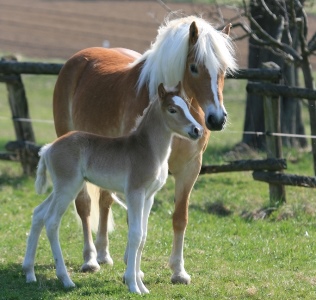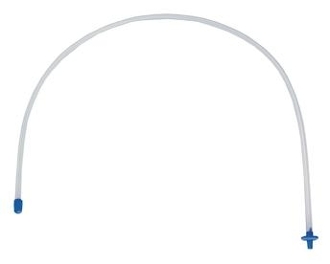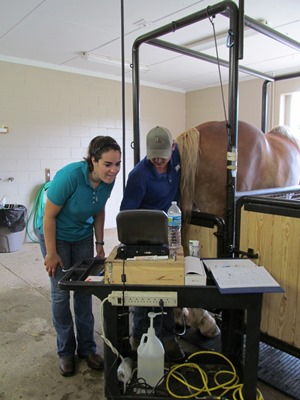 There have been many changes in how we produce foals from our broodmares in the past few decades: cooled semen, frozen semen, embryo transfer, frozen embryos, etc. One procedure that has gained popularity is deep horn insemination. This refers to placing the semen deep in the uterine horn, close to the opening of the oviduct (uterotubal junction, UTJ) on the side of ovulation instead of depositing it in the uterine body. This is typically done using a flexible pipette that can be guided to the tip of the horn with the other hand in the rectum. The end of the pipette and the tip of the uterine horn can both be felt using this method.
There have been many changes in how we produce foals from our broodmares in the past few decades: cooled semen, frozen semen, embryo transfer, frozen embryos, etc. One procedure that has gained popularity is deep horn insemination. This refers to placing the semen deep in the uterine horn, close to the opening of the oviduct (uterotubal junction, UTJ) on the side of ovulation instead of depositing it in the uterine body. This is typically done using a flexible pipette that can be guided to the tip of the horn with the other hand in the rectum. The end of the pipette and the tip of the uterine horn can both be felt using this method.
Typically, mares are inseminated with fairly large numbers of progressively motile sperm, either 500 million fresh or 1000 million cooled, into the body of the uterus about two inches in front of the cervix. Sperm are then transported to the oviduct by uterine contractions. However, it has been shown that only a few thousand sperm make it into the oviduct after insemination. This knowledge prompted studies to determine if lower sperm numbers could be used for insemination if the sperm were placed on the UTJ instead of in the uterine body.
Recent data from Select Breeders Service (SBS), based on the insemination of nearly 2000 mare cycles, showed fertility was lower with deep horn insemination compared to when semen was deposited into the uterine body. However, this study included both normal and older problem mares and used 400-800 million sperm. It is possible that deep horn insemination of a lower number of frozen sperm may be an advantage over the uterine body.
The early studies done on deep horn insemination were performed with semen that had been sexed for gender determination.
Deep horn insemination was used because the number of sexed sperm available for insemination was quite small.
 This was initially done with a flexible endoscope but later flexible pipettes (photo right; Equine IUI Pipette from Minitube) were made available. Thus, deep horn insemination could be done much easier and cheaper. With this knowledge it has become quite common for veterinarians to breed mares with frozen semen using deep horn insemination. This practice has been driven by the demand to use less than a full dose of frozen, thawed sperm to breed mares because of the cost or scarcity of the semen available from some stallions.
This was initially done with a flexible endoscope but later flexible pipettes (photo right; Equine IUI Pipette from Minitube) were made available. Thus, deep horn insemination could be done much easier and cheaper. With this knowledge it has become quite common for veterinarians to breed mares with frozen semen using deep horn insemination. This practice has been driven by the demand to use less than a full dose of frozen, thawed sperm to breed mares because of the cost or scarcity of the semen available from some stallions.
There are certainly advantages of deep horn insemination but some disadvantages exist as well. The main advantage is that if only low numbers of fresh, cooled or frozen sperm are available then deep horn insemination will be the most efficient use of that semen.
- Katila (2005) in a review article stated that, “Probably artificial insemination using doses of greater than 10 million progressively motile sperm results in equal pregnancy rates no matter if the semen is placed in the uterine body or in the horn.”
- Sieme et al (2004) in Germany reported higher pregnancy rates with frozen semen inseminated into normal mares with an endoscope versus the uterine body but the opposite was reported for problem mares.
- In a study by Reger et al (2002), they reported lower pregnancy rates when frozen semen was deposited at the UTJ than when deposited in the uterine body.
 If one looks at all of the studies it is still unclear if deep horn insemination with frozen semen has an advantage. However, based on a review of the literature it is my opinion that if the sperm dose is larger than 50 million, depositing the semen in the uterine body will result in similar pregnancy rates to deep horn insemination and there is no real advantage of deep horn insemination in these situations.
If one looks at all of the studies it is still unclear if deep horn insemination with frozen semen has an advantage. However, based on a review of the literature it is my opinion that if the sperm dose is larger than 50 million, depositing the semen in the uterine body will result in similar pregnancy rates to deep horn insemination and there is no real advantage of deep horn insemination in these situations.
In summary, whether one uses deep horn insemination or deposits the semen in the uterine body, the process of insemination used is dependent upon the type of mare (normal versus problem), dose of semen (available sperm numbers), volume of the inseminate (any volume greater that 1-2 ml is likely to drain away from the UTJ) and the competency of the inseminator (deep horn AI requires skill and practice. It is also usually performed by a veterinarian).
If you like this article you may also be interested in reading:
Influence of Mare Status When Breeding with Frozen Semen
Splitting Doses of Frozen Semen
What Exactly is a Dose of Frozen Semen?
Not All Frozen Semen is Created Equally


Log in to join the conversation.